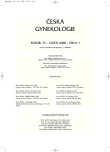The Quality of Breastfeeding Preparation in the Antenatal Courses
Authors:
A. Mydlilová 1; D. Schneiderová 2; I. Protivová 2; A. Šípek 3
Authors‘ workplace:
Národní laktační centrum, Fakultní Thomayerova nemocnice, Praha
1; Centrum preventivní medicíny, 3. lékařská fakulta UK, Praha
2; Ústav pro péči o matku a dítě, Praha
3
Published in:
Ceska Gynekol 2008; 73(1): 29-34
Overview
Objective:
To evaluate the quality of breastfeeding preparation in the antenatal courses and to identify the other sources of breastfeeding information.
Design:
Prospective study.
Setting:
Thomayer’s Hospital Prague.
Methods:
Data collected from questionnaires presented on web pages of the Lactation League from 2005 to 2006 from 351 mothers were statistically analyzed.
Results:
Only 52.8% of mothers were satisfied with the course content. Women who attended the antenatal preparation were more informed about the correct breastfeeding technique, the harmfulness bottle and pacifier usage, the disadvantages of the mother and newborn separation and alternative feeding methods than those who did not. The other sources of breastfeeding information were literature, magazines and internet. The health professional participation was only 9%. During pregnancy 82.9% of women did not pass the breast examination.
Conclusions:
It is necessary to improve the breastfeeding preparation quality of antenatal courses and to increase the health professional participation in breastfeeding information distribution.
Key words:
antenatal course content, breastfeeding
Sources
1. Bonuck, KA., Trombley, M., Freeman, M., et al. Randomized, controlled trial of prenatal and postnatal lactation consultant intervention on duration and intensity of breastfeeding up to 12 months. Pediatrics, 2005, 116, 6, p.1413-1426.
2. Buxton, KE., Gielen, AC., Faden, RR., et al. Women intending to breastfeed: predictors of early infant feeding experiences. Am J Prev Med, 1991, 7, 2, p.101-106.
3. Cattaneo, A. Breastfeeding in Europe: a blueprint for action. J Public Health, 2005, 13, p. 89-96.
4. Chapman, DJ., Damio, G., Young, S., et al. Effectiveness of breastfeeding peer counseling in a low-income, predominantly latin population: a randomized controlled trial. Arch Pediatr Adolesc Med, 2004, 158, 9, p. 897-902.
5. Chezem, JC., Friesen, C., Clark, H. Sources of infant feeding information used by pregnant women. J Perinat Educ, 2001, 10, 3, p. 20-26.
6. Desphande, AD.,Gazmarian, JA. Breast-feeding education and support: association with the decision to breast-feed. Effective Clin Practice, 2000, 3, 3, p. 141-143.
7. EU Project on Promotion of Breastfeeding in Europe. Protection, promotion and support of breastfeeding in Europe: a blueprint for action. European Commission, Directorate Public Health and Risk Assessment. Luxembourg, 2004, p. 7-32.
8. Guise, JM., Palda, V., Westhoff, C., et al. The effectiveness of primary care based interventions to promote breastfeeding: systematic evidence review and meta-analysis for the us preventive services task force. Ann Family Med, 2003, 1, 2, p. 70-78.
9. Howard, C., Howard, F., Lawrence, F., et al. Office prenatal formula advertising and its effect on breast-feeding patterns. Obstet Gynec, 2000, 95, 2, p. 296-303.
10. Jamieson, L. Getting it together. Nursing times, 1994, 90, 17, p. 68-69.
11. Kistin, N. Effect of peer counselors on breastfeeding initiation, exclusivity, and duration among low-income urban women. J Hum Lact, 1994, 10, 1, p.11-15.
12. Kogan, MD., Alexander, GR., Kotelchuck, M., et al. Comparing mothers’ reports on the content of prenatal care received with recommended national guidelines for care. Public Health Rep., 1994, 109, 5, p. 637–646.
13. Long, DG., Funk-Archuleta, MA., Geiger, CJ., et al. Peer counselor program increases breastfeeding rates in utah native american wic population. J Hum Lact,1995, 11, 4, p. 279-284.
14. Lu, MC., Prentice, J., Yu, SM., et al. Childbirth education classes: sociodemographic disparities in attendance and the association of attendance with breastfeeding initiation. Matern Child Health J,2003, 7, 2, p. 87-93.
15. McLeod, D., Puklin, S., Cookson, T. Factors influencing continuation of breastfeeding in a cohort of women. J Hum Lact, 2002, 18, p. 335-343.
16. O`Campo, P., Faden, RR., Gielen, A., et al. Prenatal factors associated with breastfeeding duration: recommendation for prenatal interventions. Birth, 1992, 19, 4, p. 195-201.
17. Partner, LM., Morton, J., Lawrence, RA., et al. Breastfeeding and the use of human milk. Pediatrics, 2005, 115, 2, p. 496-506.
18. Pugin, E., Valdés, V., Labbok, MH., et al. Does prenatal breastfeeding skills group education increase the effectiveness of a comprehensive breastfeeding promotion program? J Hum Lact,1996, 12, 1, p. 15-19.
19. Stožický, F., Schneiderová, D., Aujezdská, A., et al. Sledování výživy kojenců v prvních 6 měsících života v České republice v letech 1998-1999 (multicentrická studie). Čs Pediatr, 2001, 56, s.344-348.
20. The state of Czech obstetrics in the framework of the official research. STEM, Open Society Fund Foundation Prague - Healthy Parenthood Programme, 2000, s. 7.
21. Wiles, LS. The effect of prenatal breastfeeding education on breastfeeding success and maternal perception of the infant. JOGN Nurs., 1984, 13, 4, p. 253-257.
22. World Health Organization, Division of Child Health and Development. Evidence for the ten steps to successful breastfeeding. Ženeva, Switzerland: World Health Organization, 1998, p. 23-30.
Labels
Paediatric gynaecology Gynaecology and obstetrics Reproduction medicineArticle was published in
Czech Gynaecology

2008 Issue 1
Most read in this issue
- Caudal regression syndrome – two case reports
- Abdominal Sacrocolpopexy – Simple and Still Actual Method in the Treatment of Vaginal Vault Prolapse?
- Birth Defects, Medical Outcome and Somatic Development in Children Conceived after Intracytoplasmic Sperm Injection (ICSI)
- Thyroid Disease in the Pregnancy and Hypotrophy of Newborns
